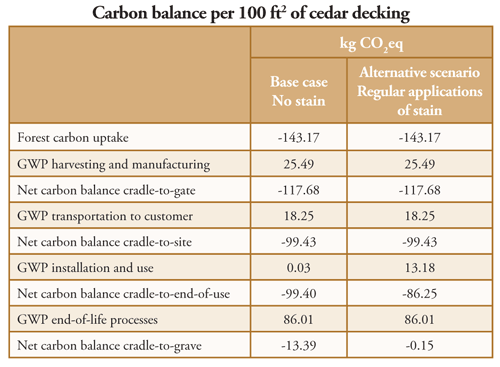Environmental Product Declarations
In terms of other environmental information, the western redcedar EPD discusses carbon balance. This is because the carbon that is part of the molecular composition of wood is derived from carbon dioxide removed from the atmosphere by the growing tree that produced the wood; this carbon is often a consideration in greenhouse gas calculations and carbon footprints for wood products. "At the manufacturing gate, wood products are typically carbon-negative; that is, more carbon is stored in the product than was emitted during harvesting and manufacturing," says O'Connor. Wood products often remain carbon-negative through their entire life cycle, but not always. "Emissions from transportation to a building site, product maintenance such as repainting, transportation to landfill, and decomposition in landfill can render wood products into net carbon emitters at the end of the full life cycle." The end-of-life processes for wood products have the most effect on cradle-to-grave carbon footprint. The EPD transparently discusses end-of-life assumptions used in calculating the carbon data.

EPDs and Wood: Where Are We?
Not surprisingly, Europe is far ahead of North America in the number of EPDs related to wood, with individual EPDs for oriented strand board, particle board, plain structural timber, sawn-dried timber and cross laminated timber, among other products. The German Institute for Construction and the Environment (IBU), for example, has developed a number of building product EPDs for use in Germany and the European Union, many of them having to do with wood3. New EU regulations may mandate the use of EPDs in the construction industry. "In Europe there is regulatory pressure to minimize carbon footprints," says Robert Glowinski, president of the American Wood Council. "In the absence of that kind of regulation, what's driving EPDs in North America is the desire for credible information on product environmental performance presented in a standardized format." Glowinski says the American Wood Council is "in the beginning stages" of developing EPDs for structural wood products, and looks forward to the contribution EPDs will eventually make to the architect's toolbox. He notes that when using EPDs, architects should look for the environmental impacts most relevant to their projects and values. "A given product won't be everybody's top pick across the board. But the beauty of an EDP is that it allows users to weight what is important to them in a given situation, be it life cycle impacts such as greenhouse gases, air quality, solid waste generated, or energy efficiency, and make an informed choice about a product based on their value system," says Glowinski.
"Within the wood industry there has been something of an awakening," says Bowyer, explaining that there is substantial attention to looking at PCRs among several industry groups including the American Forestry and Paper Association and the Hardwood Export Council. "I'm a lot more optimistic than I was a year ago."
See RESOURCES at the end of this course for a list of websites for EPDs for western redcedar decking and siding, along with select other EPDs for wood-related products.
PCRs—The Backbone of An EPD
Key to an EPD are the PCRs, Product Category Rules, which are a specific set of requirements and guidelines for developing an EPD. They form the basis of credible and comparable EPDs. "A PCR specifies allocation rules for products and co-products in the life cycle inventory aspect of an LCA, defines materials and substances and impact categories that must be reported, and establishes a time frame for data validity," says Bowyer. "Because PCRs establish rules that apply to manufacturers of an entire product category, they must be developed in consultation with a wide range of stakeholders." This open process is key to maximizing the quality of the PCR document. After the incorporation of all relevant comments, a PCR is approved and established by a technical committee typically composed of independent LCA-experts from academia and the business sector. The resulting PCR documents are usually valid for three years. If necessary they can be revised and updated after that period, or at shorter intervals should important changes arise.
Theoretically each unique product would have its own PCR, however, this would flood the market with different PCRs making comparisons difficult. When the various product groups have the same raw materials, composition, types of components, etc., the same set of general rules should be applicable to a large number of similar products. Experts say it's not necessary to reinvent the wheel with each PCR. Bowyer says that PCRs and associated LCAs need not be prepared from scratch. "They should be based on previously completed PCRs and LCAs for similar industries nationally or globally," he says.
Issues to Watch For
In the burgeoning field of EPDs, questions and concerns will certainly arise.
Architects may want to consider the following issues as they begin to incorporate EPDs into their decision making process.
Who Develops It. Who actually develops the EPD is a critical concern. For products that are similar across an industry, such as wood, a trade or technical association will typically take the lead. But for products that are unique or those that have more favorable environmental impacts than the industry norm, a single manufacturer may actually take the initiative to develop an EPD.
EPDs vs. LCAs. LCA has been widely touted as the premier means of systematically evaluating the environmental impacts linked to a product or process and for guiding process or product improvement efforts. So why add an EPD into the mix? The principal reason is that consistency is needed when comparing one product to another, both in terms of what is and isn't included when analyzing environmental impacts, and in reporting results. Rules governing the preparation of EPDs ensure that information regarding environmental performance is uniformly reported and based on apples-to-apples comparisons. An EPD also includes all relevant performance information for a given product, notably safety, human health, and other relevant issues, as well as product and company information.
 |
Project: Columbia Sportswear Company |
LEED and EPD The U.S. Green Building Council has recognized EPDs in its new LEED Pilot Credit 43 released in June. Credit can be earned via two pathways that can be combined—the certification pathway and the EPD pathway. The certification pathway rewards products with third-party labeling or certification for single or multiple environmental attributes. The EPD pathway rewards products with a life cycle assessment report or with an EPD. The stated intention is to bring awareness of certification and labeling to all products and materials (rather than singling out only some materials such as wood), and to provide an incentive for more informed material selection based on data transparency and knowledge of product life cycles. Third-party certification provides a rating but no data, while EPDs provide data but no rating. The new pilot credit recognizes the usefulness and value of both in helping inform product selection. Advocates say that EPDs help bring more multi-attribute awareness to LEED, which currently emphasizes single-attribute characteristics like recycled content and local manufacturing in its materials and resources credits. "EPDs are at the core of our approach to Materials and Resources in the next version of LEED and they are essential to move to the next level of environmental decision making about materials and products. You can think of them like a type of nutrition label. They will tell you information that you would not have had otherwise which will lead to more informed decisions, says Scot Horst, Senior Vice President of LEED, U.S. Green Building Council. "Additionally, once EPDs are widespread in the market, we will be able to set benchmarks for performance measures such as Global Warming Potential or Water. Without this information, such performance measures are almost impossible." However, LEED 2012 has not been finalized. It is still in the public comment phase as of this writing (October 2011). The second public comment period closed in September 2011, and a third public comment period is scheduled to open early in the first quarter of 2012. |









